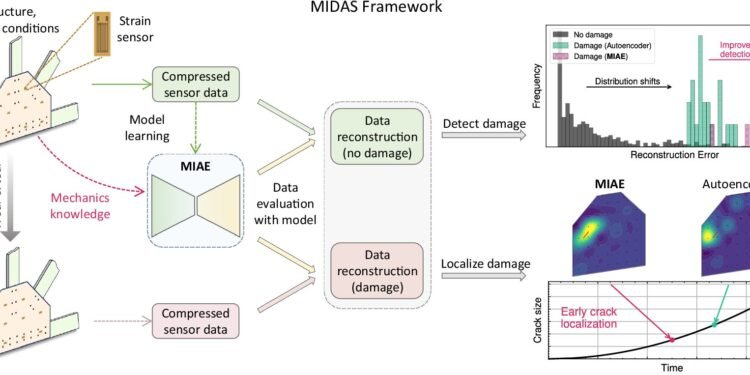
When the Francis Scott Key Bridge in Baltimore, Maryland, collapsed on March 26, 2024, engineers and city managers around the U.S. and world scrambled to assess the safety of infrastructure in their communities. Michigan State University researchers have developed a “deploy-and-forget” system that combines sensors with artificial intelligence, or AI, to assess the health of infrastructure like bridges, roads and dams, before and after events that could damage them.
“We have more than 620,000 bridges in the U.S. and we need to identify a way to maintain our aging infrastructure because we don’t have the money to rebuild it all,” said Nizar Lajnef, a professor and associate chair for graduate studies in the College of Engineering. “This is why assessment is so important to prioritize which bridges need to be maintained first.”
In the same way a smartwatch tracks your heartbeat and alerts you about potential health issues before you feel sick, this same technology can be applied to bridges and buildings. Lajnef and Vishnu Boddeti, an associate professor in the College of Engineering and MSU Mobility, collaborated on this project.
The technology, called MIDAS for Mechanics-Informed Damage Assessment of Structure, is a smart system that quietly monitors structures using inexpensive sensors and AI. The research is published in Nature Communications.
MIDAS learns how a healthy structure behaves so it can spot and locate unseen damage early, before it becomes dangerous. This AI does more than just analyze data. It is trained with mechanical knowledge, making it much better at catching issues that other systems might miss.
MIDAS detects damage in real-time by creating a custom baseline model for each structure that can autonomously identify the location and severity of damage. Ideally, MIDAS would be installed on a bridge and a custom baseline measurement would be recorded. Then, the bridge would be continuously monitored.
After an earthquake, fire, impact or any other major event, MIDAS would recheck the bridge and alert engineers in real time to any damage or weakness in the structure so that repairs can be made before a collapse occurs.
“It’s like precision health for infrastructure,” said Lajnef. “We are taking an electrocardiogram of the bridge to look and listen for abnormalities that tell us something is wrong.”
In the case of the Francis Scott Key Bridge, MIDAS could have identified weaknesses and deficiencies before the accident, allowing the bridge to be reinforced and reducing its vulnerability to the runaway barge that struck it. Another example is the recent Los Angeles fires. MIDAS could evaluate, in real time, the impact on affected bridges, buildings and roads, and provide data to assist in safe mass evacuations.
This research is also training the next generation of infrastructure experts. Doctoral students Xuyang Li and Mahdi Masmoudi contributed in developing and testing the MIDAS technology as part of their advanced research at MSU.
“We listen so that when something bad happens, we will be ready,” said Lajnef.
More information:
Xuyang Li et al, Mechanics-informed autoencoder enables automated detection and localization of unforeseen structural damage, Nature Communications (2024). DOI: 10.1038/s41467-024-52501-4
Michigan State University
Citation:
Engineers create ‘smart’ system to prevent future infrastructure disasters (2025, March 27)
retrieved 27 March 2025
from https://techxplore.com/news/2025-03-smart-future-infrastructure-disasters.html
This document is subject to copyright. Apart from any fair dealing for the purpose of private study or research, no
part may be reproduced without the written permission. The content is provided for information purposes only.










